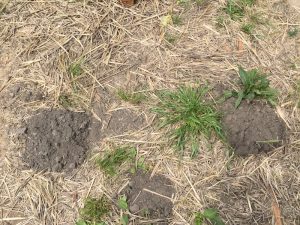Who’s Attacking My Garden?
What, pray tell, is eating your plants? Are your precious crops disappearing without a trace? Are there mounds and tunnels throughout the garden? Are there piles of beautifully granulated soil that appear freshly and carefully tilled (even though you haven’t been near that spot of ground in weeks)? Well my friends, as you probably know, you’ve got enemies underground. Today we’ll discuss how to trap gophers and moles. We’ll also talk about their lifespan and habits, destruction tactics, learn how to ID their tracks in the garden or yard, and learn some methods for keeping them out.
Gophers
Who Are They?
Here in California we’re cursed with the pocket gopher. These guys are small, only 6 – 8 inches long. They only live for a few years – most of them just 1 to 3, but some hang around this earth for 5 whole years. 5 years! They are largely pretty solitary creatures, each creating their own tunnel network to search for food in the way of plants and roots, grubs and earthworms. The pocket gopher is nocturnal and can be found tunneling through your garden at night, using its front teeth to help dig and store food it its chubby cheeks.

They typically breed in the spring, and each litter can contain between 2 – 10 babies per litter, with three to five litters per year. Once born, the baby pocket gophers set out on their own and dig new furrows that can reach up to 300 feet from where they were born. Some tunnels are shared among different gophers, and per any one-acre there are usually about 30 inhabitants.
What’s the Damage?
Once you get used to the look of gopher mounds, you can’t mistake them. As the gopher comes out of the ground, he digs and pushes the soil up ahead of him, creating a mound that spreads out into a fan shape. It will look like a freshly tilled bump on the ground.

Gophers often pull your entire plant underground, but will sometimes just tunnel through and chomp on roots. So it’s much more effective to look for mounds and their tunnels than it is to wait until you see plants disappearing.
How to Trap Gophers
I trap gophers with cinch traps, as do 90% of farmers in Sonoma County. When your livelihood depends on it, there’s just no wiggle room to allow the (estimated) 30% crop loss that gopher damage can do. For home gardeners, there are still reasons to be concerned with pests in the garden. Think of all that time, money and energy you have spent on your beautiful garden, and picture a great part of it going down the drain if your pest problem gets out of control. Not cool.
I haven’t found other methods to trap gophers that I’m happy with and work consistently. Poison will eradicate all sorts of other helpful critters and plants, and should really be avoided. Then there are all of grandma’s methods: chewing gum, orange juice and the like – for the most part, they’re not to be believed.
Two non-fatal organic options are planting things that steer gophers away, such as castor beans, around the perimeter, and lining individual plants or entire sections of the garden in gopher cages or gopher wire.
Thomas Whitman of Gophers Limited is the guru of all things gophers. He has some great tips to trap gophers including starting your trapping efforts in the center of the garden so as to only have to deal with border activity from then on, focusing on a small area at a time, and only paying attention to the freshest mounds (as that’s where you’ll get the most bang for your buck).

It’s best to trap gophers first thing in the morning as you know they have been active overnight, and in the morning you’ll be able to see the difference in color as they throw up freshly tilled soil. To find the direction of the gopher tunnel once you’ve identified the mound, think of the fan shape and what direction the gopher must have hailed from in order to throw soil in the direction where it landed.
Then start digging around. A really thin trowel or knife works best, as you want to be light with your touch. Feel around between 4-6” deep for the direction where you encounter the least resistance – there lies your tunnel! Excavate a bit of the tunnel until you can reach part of your arm into it and set your trap in there horizontally, so that nothing is obstructing the trap opening.
Come back in the morning and find your trapped and quickly killed gopher. If you miss, as we all do, try, try again!
Moles
Who Are They?
Moles aren’t after your plants as much as they are after water, and grubs, worms and snails (but that doesn’t mean they won’t do damage to your plants). Unlike gophers, they only have one litter per year.

What’s the Damage?
Moles often dig shallow tunnels through the garden, following the water lines. I can’t tell you how many times I’ve sunken my hand into a bed of plants to see what’s going on, only to find that my hand plunges into a shallow tunnel of thin air that I can follow all the way through the bed. They’re not eating my plants, they are merely digging around and drinking the water meant to irrigate my plants, leaving roots growing into thin air. Some plants manage to grow right through it, while others become stunted.
How to Trap Moles
Mole trapping is pretty similar to gopher trapping, but it’s a little trickier. Moles are more difficult to catch and often quickly wise up to your trapping tricks, meaning that if you miss once, the second try will be a little harder.
Final Words of Advice
The best advice on getting to know these rodents is to really get out and feel around in your soil, notice daily changes, and feel around for tunnels. After you know what’s going on and who is tunneling underground, you’ll well on your way to being able to keep them at bay.







 Family
Family

